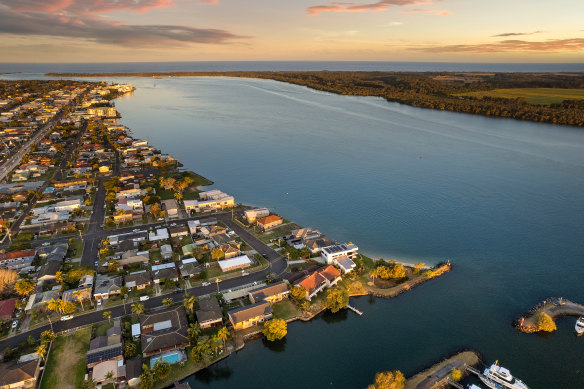This was published 1 year ago
The NSW sea change towns where house prices fell most
Interest rate rises have taken the heat out of the NSW regional property market, pushing house prices lower in a string of once-rising towns.
The market is now at its most stable since 2010, as the median house price across regional NSW held steady at $730,000 in the December quarter, the latest Domain House Price Report shows. It is up 1.4 per cent in the 12 months to December.
Some of the most popular sea and tree change regions are still recording price declines but at a slower pace.
Lismore, which continues to feel the impact of unprecedented floods, recorded the largest fall in prices again. House prices in the regional local government area dropped 19.2 per cent to a median $493,000, from $610,000 in December 2022.
That was followed by Yass Valley (down 12.3 per cent), Murray River (down 10.7 per cent) and Armidale (down 9.6 per cent). More popular coastal areas of Ballina, Mid-Coast and Byron Shire all recorded less than 10 per cent declines.
Meanwhile, more far-flung regional council areas are still recording increases, albeit at a slower pace. Moree Plains council area recorded the largest increase of 20.4 per cent taking its median house price to $288,250.

House prices declined in the Ballina council area last year but there is renewed confidence in the market.Credit: Fairfax Media
Domain chief of research and economics Dr Nicola Powell said regional house prices across NSW had held steady for six months, the first time in more than a decade.
“They’ve held steady for two quarters in a row. That is the most stable period we’ve seen since 2010,” Powell said.
“The ones that are growing look to be more affordable locations, further away from working hubs,” she said. “Many of these LGAs have moved through their peak rate of decline, and I’m expecting though some of these regions that are seeing strong growth will nudge down.”
But Powell noted other areas like Byron, Kiama, Shoalhaven and Eurobodalla were showing signs of improved conditions.
“I’m not saying we’re going to see boom-time scenario prices. Some of these areas with deeper downturns will see an improvement and the other areas will see a slower pace,” she said.
Powell said regions that are not within a reasonable commuting distance to employment hubs will be hit harder as employers call for workers to spend more days at the office.
But KPMG’s director of planning and infrastructure economics Terry Rawnsley said regional NSW was now in a boom and bust cycle - especially in sought after lifestyle locations.
In NSW, towns in the mortgage belts including the Lismore, Yass Valley and Murray River LGAs were being particularly hard hit by interest rate rises, while the floods in some parts of NSW were also having an impact.
Many buyers were moving further afield to be able to find an available home they can afford.
“There’s a ripple effect going on,” Rawnsley said. “Outside of Canberra, people priced out of Queanbeyan go to Goulburn or Yass – those far-flung areas – because they can go further away and save $200,000 on a house.”
Rawnsley said he expected moves to regional NSW to return to a normal rhythm this year, with younger people expected to move for study or work, and those 35 and older returning to their hometowns with a family in tow.
Many of those who left the city to work remotely would stay put, he said.
He said the government needed to think about the housing needs of regional areas, with much more needed to attract city dwellers to country NSW.
“The 20 per cent drop we’ve seen in the last two years is more of an adjustment of where it would have been without COVID taking place.”
Belle Property Byron Bay and Lennox Heads principal Brendan Walters said there was price a correction in Ballina after skyrocketing during COVID.
He said interest rates had also taken a toll on home owners and buyers in the region.
“Given interest rates were the biggest factor, downward pressure on affordability was the major issue we dealt with last year,” Walters said. “There was a slight oversupply of stock. People mainly selling their investment properties.”
But he said the market’s decline had spurred on confidence again from buyers who were a mix of locals, south-east Queenslanders, Sydneysiders and Melburnians.
“People are realising they are buying 20 per cent less than what it was two years ago,” he said, although it was out of first home buyers’ reach.
McGrath Albury and Wodonga’s Sue Moss said the last two interest rate rises last year had hit the Albury market towards the end of the year despite the area recording an 8.8 per cent increase in 2023.
“It’s definitely slowed for the last four to five months. The competition hasn’t been there as much,” Moss said, adding the last interest rate rise meant the market pulled back, and out-of-town buyer demand had fallen to lower levels.